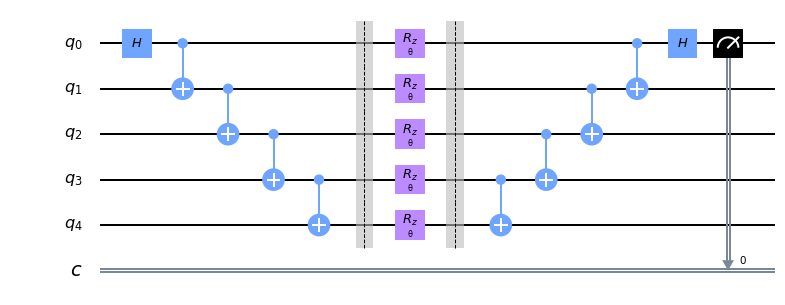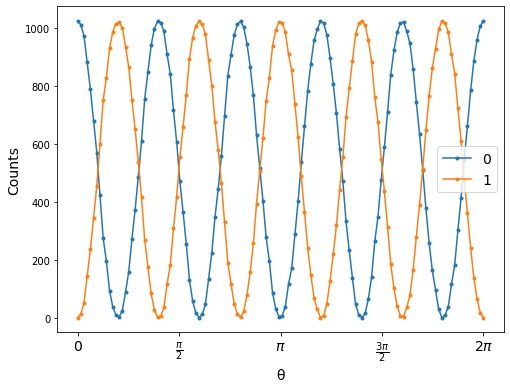Advanced Circuits¶
[1]:
import numpy as np
from qiskit import *
Opaque gates¶
[2]:
from qiskit.circuit import Gate
my_gate = Gate(name='my_gate', num_qubits=2, params=[])
[3]:
qr = QuantumRegister(3, 'q')
circ = QuantumCircuit(qr)
circ.append(my_gate, [qr[0], qr[1]])
circ.append(my_gate, [qr[1], qr[2]])
circ.draw()
[3]:
┌──────────┐
q_0: ┤0 ├────────────
│ my_gate │┌──────────┐
q_1: ┤1 ├┤0 ├
└──────────┘│ my_gate │
q_2: ────────────┤1 ├
└──────────┘Composite Gates¶
[4]:
# Build a sub-circuit
sub_q = QuantumRegister(2)
sub_circ = QuantumCircuit(sub_q, name='sub_circ')
sub_circ.h(sub_q[0])
sub_circ.crz(1, sub_q[0], sub_q[1])
sub_circ.barrier()
sub_circ.id(sub_q[1])
sub_circ.u3(1, 2, -2, sub_q[0])
# Convert to a gate and stick it into an arbitrary place in the bigger circuit
sub_inst = sub_circ.to_instruction()
q = QuantumRegister(3, 'q')
circ = QuantumCircuit(q)
circ.h(qr[0])
circ.cx(qr[0], qr[1])
circ.cx(qr[1], qr[2])
circ.append(sub_inst, [q[1], q[2]])
circ.draw()
[4]:
┌───┐
q_0: ┤ H ├──■────────────────────
└───┘┌─┴─┐ ┌───────────┐
q_1: ─────┤ X ├──■──┤0 ├
└───┘┌─┴─┐│ sub_circ │
q_2: ──────────┤ X ├┤1 ├
└───┘└───────────┘Circuits are not immediately decomposed upon conversion to_instruction to allow circuit design at higher levels of abstraction. When desired, or before compilation, sub-circuits will be decomposed via the decompose method.
[5]:
decomposed_circ = circ.decompose() # Does not modify original circuit
decomposed_circ.draw()
[5]:
┌──────────┐
q_0: ┤ U2(0,pi) ├──■──────────────────────────────────────
└──────────┘┌─┴─┐ ┌───┐ ░ ┌────────────┐
q_1: ────────────┤ X ├──■──┤ H ├────■─────░─┤ U3(1,2,-2) ├
└───┘┌─┴─┐└───┘┌───┴───┐ ░ └───┬───┬────┘
q_2: ─────────────────┤ X ├─────┤ RZ(1) ├─░─────┤ I ├─────
└───┘ └───────┘ ░ └───┘ Parameterized circuits¶
[6]:
from qiskit.circuit import Parameter
theta = Parameter('θ')
n = 5
qc = QuantumCircuit(5, 1)
qc.h(0)
for i in range(n-1):
qc.cx(i, i+1)
qc.barrier()
qc.rz(theta, range(5))
qc.barrier()
for i in reversed(range(n-1)):
qc.cx(i, i+1)
qc.h(0)
qc.measure(0, 0)
qc.draw('mpl')
[6]:

We can inspect the circuit’s parameters
[7]:
print(qc.parameters)
{Parameter(θ)}
Binding parameters to values¶
All circuit parameters must be bound before sending the circuit to a backend. This can be done in one of two ways: - The bind_parameters method accepts a dictionary mapping Parameters to values, and returns a new circuit with each parameter replaced by its corresponding value. Partial binding is supported, in which case the returned circuit will be parameterized by any Parameters that were not mapped to a value.
[8]:
import numpy as np
theta_range = np.linspace(0, 2 * np.pi, 128)
circuits = [qc.bind_parameters({theta: theta_val})
for theta_val in theta_range]
circuits[-1].draw()
[8]:
┌───┐ ░ ┌─────────┐ ░ ┌───┐┌─┐
q_0: ┤ H ├──■──────────────────░─┤ RZ(2pi) ├─░──────────────────■──┤ H ├┤M├
└───┘┌─┴─┐ ░ ├─────────┤ ░ ┌─┴─┐└───┘└╥┘
q_1: ─────┤ X ├──■─────────────░─┤ RZ(2pi) ├─░─────────────■──┤ X ├──────╫─
└───┘┌─┴─┐ ░ ├─────────┤ ░ ┌─┴─┐└───┘ ║
q_2: ──────────┤ X ├──■────────░─┤ RZ(2pi) ├─░────────■──┤ X ├───────────╫─
└───┘┌─┴─┐ ░ ├─────────┤ ░ ┌─┴─┐└───┘ ║
q_3: ───────────────┤ X ├──■───░─┤ RZ(2pi) ├─░───■──┤ X ├────────────────╫─
└───┘┌─┴─┐ ░ ├─────────┤ ░ ┌─┴─┐└───┘ ║
q_4: ────────────────────┤ X ├─░─┤ RZ(2pi) ├─░─┤ X ├─────────────────────╫─
└───┘ ░ └─────────┘ ░ └───┘ ║
c_0: ════════════════════════════════════════════════════════════════════╩═
qiskit.executenow accepts aparameter_bindskeyword argument which, when specified as a list of dictionaries mappingParameters to values, will bind and execute a circuit on the backend for every mapping dictionary in the list.
[9]:
job = execute(qc,
backend=BasicAer.get_backend('qasm_simulator'),
parameter_binds=[{theta: theta_val} for theta_val in theta_range])
counts = job.result().get_counts()
In the example circuit, we apply a global \(R_z(\theta)\) rotation on a five-qubit entangled state, and so expect to see oscillation in qubit-0 at \(5\theta\).
[10]:
import matplotlib.pyplot as plt
fig = plt.figure(figsize=(8,6))
ax = fig.add_subplot(111)
ax.plot(theta_range, list(map(lambda c: c.get('0', 0), counts)), '.-', label='0')
ax.plot(theta_range, list(map(lambda c: c.get('1', 0), counts)), '.-', label='1')
ax.set_xticks([i * np.pi / 2 for i in range(5)])
ax.set_xticklabels(['0', r'$\frac{\pi}{2}$', r'$\pi$', r'$\frac{3\pi}{2}$', r'$2\pi$'], fontsize=14)
ax.set_xlabel('θ', fontsize=14)
ax.set_ylabel('Counts', fontsize=14)
ax.legend(fontsize=14)
[10]:
<matplotlib.legend.Legend at 0x11dce80a0>

Reducing compilation cost¶
Compiling over a parameterized circuit prior to binding can, in some cases, significantly reduce compilation time as compared to compiling over a set of bound circuits.
[11]:
import time
from itertools import combinations
from qiskit.compiler import assemble
from qiskit.test.mock import FakeVigo
start = time.time()
qcs = []
theta_range = np.linspace(0, 2*np.pi, 32)
for n in theta_range:
qc = QuantumCircuit(5)
for k in range(8):
for i,j in combinations(range(5), 2):
qc.cx(i,j)
qc.rz(n, range(5))
for i,j in combinations(range(5), 2):
qc.cx(i,j)
qcs.append(qc)
compiled_circuits = transpile(qcs, backend=FakeVigo())
qobj = assemble(compiled_circuits, backend=FakeVigo())
end = time.time()
print('Time compiling over set of bound circuits: ', end-start)
Time compiling over set of bound circuits: 8.771650075912476
[12]:
start = time.time()
qc = QuantumCircuit(5)
theta = Parameter('theta')
for k in range(8):
for i,j in combinations(range(5), 2):
qc.cx(i,j)
qc.rz(theta, range(5))
for i,j in combinations(range(5), 2):
qc.cx(i,j)
transpiled_qc = transpile(qc, backend=FakeVigo())
qobj = assemble([transpiled_qc.bind_parameters({theta: n})
for n in theta_range], backend=FakeVigo())
end = time.time()
print('Time compiling over parameterized circuit, then binding: ', end-start)
Time compiling over parameterized circuit, then binding: 0.8169369697570801
Composition¶
Parameterized circuits can be composed like standard QuantumCircuits. Generally, when composing two parameterized circuits, the resulting circuit will be parameterized by the union of the parameters of the input circuits.
However, parameter names must be unique within a given circuit. When attempting to add a parameter whose name is already present in the target circuit: - if the source and target share the same Parameter instance, the parameters will be assumed to be the same and combined - if the source and target have different Parameter instances, an error will be raised
[13]:
phi = Parameter('phi')
sub_circ1 = QuantumCircuit(2, name='sc_1')
sub_circ1.rz(phi, 0)
sub_circ1.rx(phi, 1)
sub_circ2 = QuantumCircuit(2, name='sc_2')
sub_circ2.rx(phi, 0)
sub_circ2.rz(phi, 1)
qc = QuantumCircuit(4)
qr = qc.qregs[0]
qc.append(sub_circ1.to_instruction(), [qr[0], qr[1]])
qc.append(sub_circ2.to_instruction(), [qr[0], qr[1]])
qc.append(sub_circ2.to_instruction(), [qr[2], qr[3]])
print(qc.draw())
# The following raises an error: "QiskitError: 'Name conflict on adding parameter: phi'"
# phi2 = Parameter('phi')
# qc.u3(0.1, phi2, 0.3, 0)
┌────────────┐┌────────────┐
q_0: ┤0 ├┤0 ├
│ sc_1(phi) ││ sc_2(phi) │
q_1: ┤1 ├┤1 ├
├────────────┤└────────────┘
q_2: ┤0 ├──────────────
│ sc_2(phi) │
q_3: ┤1 ├──────────────
└────────────┘
To insert a subcircuit under a different parameterization, the to_instruction method accepts an optional argument (parameter_map) which, when present, will generate instructions with the source parameter replaced by a new parameter.
[14]:
p = Parameter('p')
qc = QuantumCircuit(3, name='oracle')
qc.rz(p, 0)
qc.cx(0, 1)
qc.rz(p, 1)
qc.cx(1, 2)
qc.rz(p, 2)
theta = Parameter('theta')
phi = Parameter('phi')
gamma = Parameter('gamma')
qr = QuantumRegister(9)
larger_qc = QuantumCircuit(qr)
larger_qc.append(qc.to_instruction({p: theta}), qr[0:3])
larger_qc.append(qc.to_instruction({p: phi}), qr[3:6])
larger_qc.append(qc.to_instruction({p: gamma}), qr[6:9])
print(larger_qc.draw())
print(larger_qc.decompose().draw())
┌────────────────┐
q1_0: ┤0 ├
│ │
q1_1: ┤1 oracle(theta) ├
│ │
q1_2: ┤2 ├
└┬──────────────┬┘
q1_3: ─┤0 ├─
│ │
q1_4: ─┤1 oracle(phi) ├─
│ │
q1_5: ─┤2 ├─
┌┴──────────────┴┐
q1_6: ┤0 ├
│ │
q1_7: ┤1 oracle(gamma) ├
│ │
q1_8: ┤2 ├
└────────────────┘
┌───────────┐
q1_0: ┤ RZ(theta) ├──■─────────────────────────────────
└───────────┘┌─┴─┐┌───────────┐
q1_1: ─────────────┤ X ├┤ RZ(theta) ├──■───────────────
└───┘└───────────┘┌─┴─┐┌───────────┐
q1_2: ───────────────────────────────┤ X ├┤ RZ(theta) ├
┌─────────┐ └───┘└───────────┘
q1_3: ─┤ RZ(phi) ├───■─────────────────────────────────
└─────────┘ ┌─┴─┐ ┌─────────┐
q1_4: ─────────────┤ X ├─┤ RZ(phi) ├───■───────────────
└───┘ └─────────┘ ┌─┴─┐ ┌─────────┐
q1_5: ───────────────────────────────┤ X ├─┤ RZ(phi) ├─
┌───────────┐ └───┘ └─────────┘
q1_6: ┤ RZ(gamma) ├──■─────────────────────────────────
└───────────┘┌─┴─┐┌───────────┐
q1_7: ─────────────┤ X ├┤ RZ(gamma) ├──■───────────────
└───┘└───────────┘┌─┴─┐┌───────────┐
q1_8: ───────────────────────────────┤ X ├┤ RZ(gamma) ├
└───┘└───────────┘
[15]:
import qiskit.tools.jupyter
%qiskit_version_table
%qiskit_copyright
Version Information
| Qiskit Software | Version |
|---|---|
| Qiskit | None |
| Terra | 0.15.0 |
| Aer | 0.5.1 |
| Ignis | None |
| Aqua | None |
| IBM Q Provider | 0.7.0 |
| System information | |
| Python | 3.8.2 (default, Mar 26 2020, 10:43:30) [Clang 4.0.1 (tags/RELEASE_401/final)] |
| OS | Darwin |
| CPUs | 4 |
| Memory (Gb) | 16.0 |
| Fri May 08 08:42:21 2020 EDT | |
This code is a part of Qiskit
© Copyright IBM 2017, 2020.
This code is licensed under the Apache License, Version 2.0. You may
obtain a copy of this license in the LICENSE.txt file in the root directory
of this source tree or at http://www.apache.org/licenses/LICENSE-2.0.
Any modifications or derivative works of this code must retain this
copyright notice, and modified files need to carry a notice indicating
that they have been altered from the originals.
[ ]: